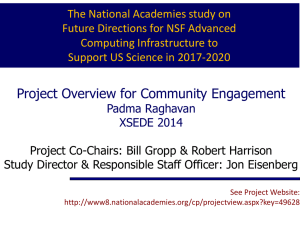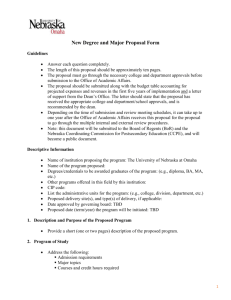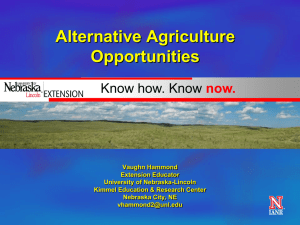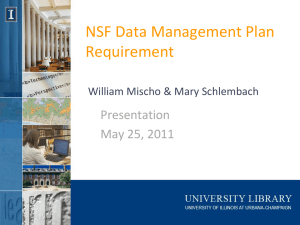Answering the Big Questions presented by Kathie Olsen
advertisement
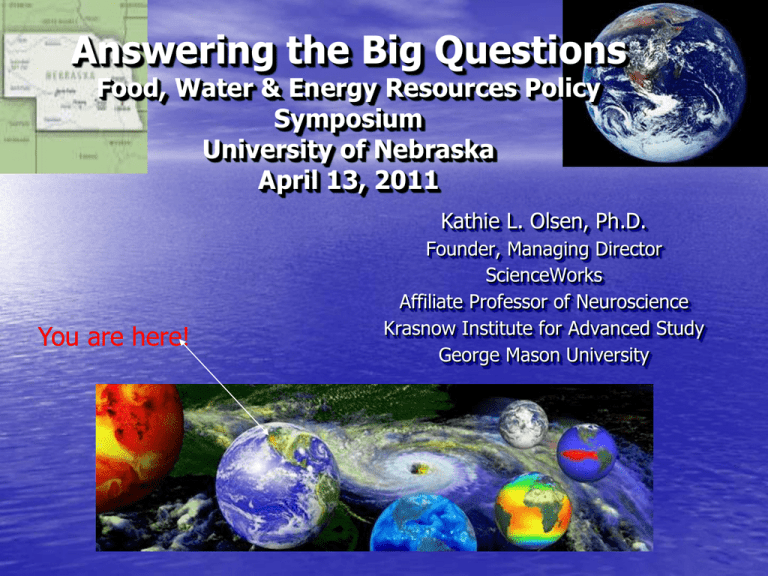
Answering the Big Questions Food, Water & Energy Resources Policy Symposium University of Nebraska April 13, 2011 Kathie L. Olsen, Ph.D. You are here! Founder, Managing Director ScienceWorks Affiliate Professor of Neuroscience Krasnow Institute for Advanced Study George Mason University Humanity’s Top Ten Problems for next 50 years* 1. 2. 3. 4. 5. 6. 7. 8. 9. 10. ENERGY WATER FOOD ENVIRONMENT POVERTY TERRORISM & WAR DISEASE EDUCATION DEMOCRACY POPULATION Richard Smalley, Noble Laureate, Rice University* Need both the “stovepipes” But even more importantly the CONNECTIONS/INTEGRATION Major role of university in solving these major societal challenges 2003 2050 6.3 9-10 Billion People Billion People Agriculture Irrigation Climate Change Energy Demographics Allocation Economics Sustainability Security Fishing Swimming Drinking Habitat Recreation Biological integrity National Science & Technology (NSTC) SUBCOMMITTEE ON WATER AVAILABILITY AND QUALITY Co-Chairs: USGS & EPA Purpose: Science issues and policy related to needed improvements in technology and research that will advance the goal of ensuring a safe and sustainable supply of water in the United States for human and ecological needs. WATER AVAILABILITY AND QUALITY “Are the supplies of water for human and ecological uses sustainable for decades into the future? If not, how might we develop new supplies or better manage for sustainability? “ Questions addressed by NSTC Subcommittee On Water Availability & Quality, OSTP, Presentation 2003 Integrated Earth Observing System Satellite Remote Sensing Data Aircraft Remote Sensing Data In Situ Data Sensors Aircraft Balloons Moored & drifting buoys Ships & Submarines IOOS: Artist ‘s depiction of various space MAJOR WORKING GROUP ON WATER air, and water platforms as Part off the IOOS The Program Decision Process Top down (Agency management, OMB, Congress) - Ideas - Concepts - Planning - Capability development Bottom’s up (academia, industry, agency S&E personnel) - Priorities - Budget - Strategic Planning - DECISIONS Establishing Program Priorities Science Priority Criteria Science Return Benefit to Society Mandated Program Appropriate for support govt, state, private Partnership Opportunity Technology Readiness Program Balance Cost/Budget Context Implementation Priority Criteria NSF: Water Initiative Water Sustainability & Climate •Interdisciplinary Approach •BIO •GEO: Earth Science •SBE •ENG 2008 Water Science Forum Practical Cutting-Edge Technology for Water Services: Applications in Africa UNESCO USGov NSF STC & ERC “Water is a Precious Resource* Jeff Raikes, CEO, Bill & Melinda Gates Foundation Food/Agriculture Crop per Drop Feed the Future Global Climate Change Adaptation Mitigation Human Impacts Green-Energy Technologies Biofuel industry *Proceedings of the 2010 Water for Food Conference Feed the Future (FTF) • USAID/USDA released “Feed the Future: Global Food Security Research Strategy (Dec 2011) • • • • Advancing the Productivity Frontier Transforming Key Production Systems Enhancing Food Safety & Nutrition Cross-Cutting Issues: Gender, Climate Change & Environment • APLU/PURDUE/BIFAD/USAID/USDA Workshop at Purdue (Jan. 2011) • Ken Cashman* & Shenggen Fan Speakers • “A Research Strategy for Feed the Future” Summary of Discussions and Conclustions • E-Consultation to Produce a White Paper – FTF Research Forum • Washington, DC June 21-23, 2011 (co-with World Food Prize) Water & Agriculture Major Drivers Major components needed to understand the climate system and climate change. Source: Strategic Plan for the Climate Change Science Program Final Report, July 2003 Fig.2-5 Adapted from IPCC (2001a) U.S. ENERGY CONSUMPTION TRENDS THROUGH 2020 (Energy Information Administration, Annual Energy Outlook, 2002) University of Nebraska Longtime Leader in Research in Water, Agricultural & Natural Resources Management Integrates Water Research with Education Integrates Research with Policy Analysis Researchers have Flexibility Capitalize on breakthroughs and emerging area Collaborate across disciplines, institutions & countries Collaborate with industry and non-profits Cultivate Interdisciplinary Expertise in Research and Education to Tackle World Challenge Public Service and Education to the Community Ken Cassman’s Proceedings of the Water for Food Conference Nebraska can be a leader in “Future Water for Food Challenge” Location Location Location Western Edge-Great American Desert Eastern Edge-Corn Belt Irrigation Irrigation Irrigation Derives $10,000 per capital from agriculture (more than any other state) Nebraska’s Green Revolution based on new Science & Technology Increase rate of gain in ethanol production compared with other states Biofuel Industry new within last 15 yrs: 1.8B gals fuel =$3B yr, 1000 jobs and $1.5B in capital investment Natural Resources Districts model for water management Nebraska’s Role in Water & Water for Food Centers • Regional intellectual centers – Education – Basic research • Centers for innovation and technology transfer • Role in regional economic development • Role in workforce preparation – Partnerships with schools, other educational institutions • Bridging the university community and the region’s industrial community through Innovation Campus NSF Engineering Research Centers • Promote partnerships among researchers – in different disciplines – between industry and universities • Focus on integrated engineered systems & technological innovations that strengthen the competitive position of industry • Graduates become well-rounded, professionally oriented engineers – global outlook, – experience in technological innovation – ability to assume leadership roles in industry, academe, and government • Generation Three (Gen-3) Engineering Research Centers (ERC) – link discovery to technological innovation through transformational fundamental and engineered systems research – advance technology and produce engineering graduates who will be creative U.S. innovators in a globally competitive economy. – Gen-3 ERCs must have an international partner! • Active ERCs: http://www.erc-assoc.org/ • I NSF Science &Technology Centers • Integrative Partnerships program enables innovative research and education projects of national importance that require a Center mode of support – research, education, and knowledge-transfer goals – conduct world-class research in partnerships among academic institutions, national laboratories, industrial organizations, and/or other public/private entities • create new and meaningful knowledge of significant benefit to society • Deadline for Preproposals: May 30, 2011 • All Active Centers Web Page: – http://www.nsf.gov/od/oia/programs/stc/2000-2006.jsp “The interaction of human activity with natural systems is a web of complex interactive and interdependent processes. If people or nature tugs on one part of the web, other parts of the web change, sometimes in unintended and unpredictable ways.” OSTP presentation, 2003 Or as Nebraskan Larry Dedic says: “For every action there will be a reaction” There are no passengers on spaceship earth. We are all crew. Marshall McLuhan (1911 - 1980)






